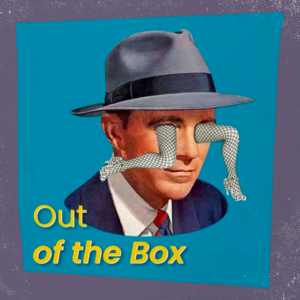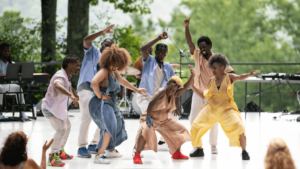Irina in the Teaching Swing Dance group on facebook just asked:
Hey folks! I have a question I’d like to crowd source for. How do you teach rhythm to folks who don’t inherently understand it? As in those who can’t stay on beat and don’t know they’re off beat even after months or sometimes years of classes. I’m teaching a group class focused on this topic this month and I’d love to hear some tactics and success stories from y’all!
And since I’ve been teaching 30 minute drop in classes for the monthly Blue Rhythm Band gig, I’m full of excitement about teaching again. This is what I wrote:
Oooh! My favourite thing!
So I actually think that keeping time (ie finding the beat) and rhythm are the most important things in lindy hop. It’s how we connect with the music and our partners.
So when I’m teaching brand new dancers (heck, any dancers), I begin with a big apple style jazz warm up, where one teacher leads the group through a series of jazz steps, changing step on the phrase. This teaches students:
– to be present (ie they have to concentrate, so they stop thinking about work, etc)
– about phrasing (but with no obligation to find it themselves; if they’re not ready to hear it, then that’s ok, the teacher’s go it)
– about the beat (the teacher demos how to dance in time)
– to dance on their own before touching another human (much easier than partner dancing)
– to move on from mistakes rather than stressing about them; have to move on – the next step’s coming
– some basic jazz repertoire.
The teacher should be mindful about the rhythms they use. eg using simpler rhythms (single time or half time) first, then adding complexity. eg I might begin with walking on the spot, then walking + a clap on 8, then it becomes fall off the log with some shape.
It’s also good to give students some small victories in the first few seconds, so they feel confident. So start simple, then get more complex later.
-> this is 3-5 minutes. If they’re loving it, do another song!
After this we play i-go, you-go. I intro this by saying ‘now we’re going to play a game to learn the rhythm we’ll use all class.’
Then we play:
– I clap the basic rhythm (if it’s for lindy hop, it’s ‘slow slow, slow quick slow’, if it’s charleston it’s 8-1, 3-4 or however you think of charleston, etc).
It’s 8 counts (2 bars) in a moderate tempo (not too fast), swinging.
– They immediately repeat it back to me
– I clap the same rhythm….
This goes on in real time, with the same tempo. I move from clapping it to tapping it with different parts of my feet, with different feet, then step it out, then move it around. You can also scat it.
The other teacher is ‘on their team’ so they have a model for what to do.
As the ‘caller’ (they’re the responders), you pay attention to how they’re going. If they’re struggling, make it a bit simpler. Repeat something. If they’re all over it, add in elements like the shape of your body, where you place your feet, etc. The great thing about this is that if they’re not ready to work on these ‘extra’ things, they won’t see them because they’re too focussed on the basic stuff. Don’t stop and articulate this; just let it be there for the students to see when they’re ready.
Do not stop and explain things or correct or ‘break things down’. This is essential. This teaches them how to keep time _in real time_. It also teaches them how to learn-by-seeing and learn-by-doing. Just as we would on the social floor. This is one way you might think about building Black street dance tradition into your classes. But defs not the definitive or final way!
You don’t have to say ‘rhythm is the most important part of lindy hop’. By having it right up front as the first thing, you’re showing them that rhythm is important.
It’s ok to say ‘yes!’ or positive comments and noises when they really do stuff that impresses you. Show them how to be a receptive, appreciative audience.
The goals:
– learn how to learn without having a move ‘broken down’ for them verbally. They learn how to ‘break it down’ themselves, into the parts that matter to them – eg they might be ready for foot tapping, but not ready to see which foot it is; they might be ready for hitting the last 4 beats, but keep missing the first 4.
– get them used to moving on from mistakes without stopping to stress
– feeling confident trying instead of stopping to think before trying
– starting simple (clapping), then getting more complex (stepping the rhythm through space)
– they make a few mistake at first as people figure out how to play, but keep going. This teaches people that it’s ok to stumble through until you figure out what you’re doing. This teaches you to feel confident in mistakes. No one stops to correct you (and tell you you’re doing it wrong), no one judges.
– saying it’s a game is essential: game connotes fun, no pressure, play. ‘exercise’ or ‘rudiments’ feels like more pressure. Also, it’s fun.
– we start with this simple version so that they can learn how to play before we move onto more complex or challenging games later.
– they are all on one team (rather than one person clapping in front of the whole group).
By the end of this, 99% of them will be keeping good time and will have mastered the rhythm. They’ll also be a bit fatigued (brain wise), so change tasks.
-> this takes about 5 minutes max.
If it’s a normal class, I then have them play the same game with a partner, one-on-one. They take turns being the ‘caller’ and ‘responder’. You can have them do exactly the same thing (clapping the same rhythm with different shapes) or you can have them do different stuff (eg jazz steps, different rhythms, etc).
Goals:
– they learn to watch their partner and figure out rhythms from watching
– they start learning (from being a caller) that the goal isn’t to be best rhythm-composer, but best communicator of rhythm
– their weight changes and clarity of shape get really really good; it has to be super clear so their partner can figure it out. They’re not always aware of this.
– they learn to keep time and recognise and then reproduce rhythms
– Most amazing (and I only realised this after observing them carefully) they actually start orienting their bodies _towards_ their partners, with that lovely active balance (weight forwards, core engaged), the ‘perfect’ distance apart. So when they partner up in closed THEY ALREADY KNOW HOW TO HAVE ‘LINDY HOP BODY’ !!!!
-> this takes about 5 minutes.
From here they go on to partnering up.
I find that they are 100% ok with doing the nice rhythm (step step triple step), they keep lovely time, and if you play a nice song, they SWING IT. They also don’t need to be counted in, and can find ‘1’ easily.
All this takes about 15 minutes. I find that this investment in time gives them the skills to really _learn_. If you then move on to teach ‘moves’ by saying ‘please observe us, then reproduce it as best you can’ they are happy to just give it a go. You don’t need to break it down, they learn faster (and dance more), and they actually learn better and retain more.
Important things:
– never ‘correct’. Every time you correct a student (‘just one tip’ is a correction), you’re essentially telling them that they’re doing it wrong. This lowers self esteem and confidence, and actually makes it harder to learn. Happy people learn faster, retain more, and are braver and more confident.
– if you want to praise, make it process-oriented. ie don’t say ‘that was amazing!’ say stuff like ‘I saw X and Y get into a mess, then stop, laugh, take a breath, then restart. This was really effective’. This will give X and Y positive vibes, but it will also give the rest of the group info on what they might try, and it generally makes YOU feel fantastic, because you’re looking at your students to find good things, rather than looking at them to find bad things.
I have one hundred million things to say about this, and have posted about it a million times in this group (you can find it if you search for ‘i-go’, etc), and a lot of clever teachers have made suggestions and helped me learn about this stuff. It’s SO MUCH FUN!
Props:
I learnt this approach from taking classes with tappers Josette and Joseph Wiggan, and with Thomas Moon. Ramona Staffeld’s kind-but-clear approach to teaching helped us refine the approach. Classes with OGs like Chazz Young taught me that I can learn and do ok if I just keep trying and don’t have a teacher hold my hand. Josette taught me to not ask questions when I was confused, but to just have a go instead.
Our Swing Dance Sydney teaching group developed this approach together; I was just one person in the 6 person team.
The students themselves offered lots of feedback and suggestions on these things. We’d ask them ‘what did you think about this game?’ and they’d give us useful answers















